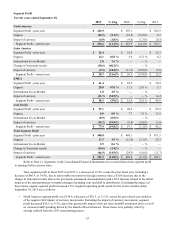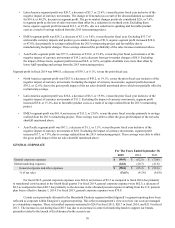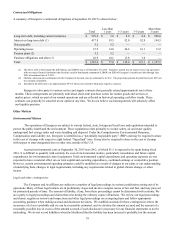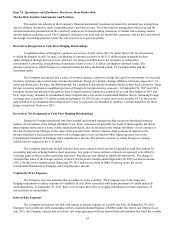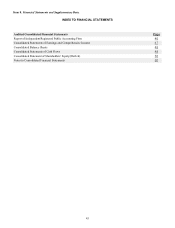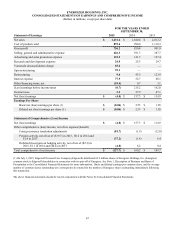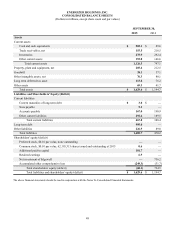Energizer 2015 Annual Report Download - page 46
Download and view the complete annual report
Please find page 46 of the 2015 Energizer annual report below. You can navigate through the pages in the report by either clicking on the pages listed below, or by using the keyword search tool below to find specific information within the annual report.42
We regularly repatriate a portion of current year earnings from select non-U.S. subsidiaries. Generally, these non-U.S.
subsidiaries are in tax jurisdictions with effective tax rates that do not result in materially higher U.S. tax provisions
related to the repatriated earnings. No provision is made for additional taxes on undistributed earnings of foreign
affiliates that are intended and planned to be indefinitely invested in foreign affiliates. We intend to reinvest these
earnings indefinitely in our foreign subsidiaries to fund local operations, fund strategic growth objectives, and fund
capital projects. See Note 8, Income Taxes, of the Notes to Consolidated Financial Statements for further discussion.
The Company estimates income taxes and the effective income tax rate in each jurisdiction that it operates. This
involves estimating taxable earnings, specific taxable and deductible items, the likelihood of generating sufficient
future taxable income to utilize deferred tax assets, the portion of the income of foreign subsidiaries that is expected to
be remitted to the U.S. and be taxable and possible exposures related to future tax audits. Deferred tax assets are
evaluated on a subsidiary by subsidiary basis to ensure that the asset will be realized. Valuation allowances are
established when the realization is not deemed to be more likely than not. Future performance is monitored, and when
objectively measurable operating trends change, adjustments are made to the valuation allowances accordingly. To the
extent the estimates described above change, adjustments to income taxes are made in the period in which the estimate
is changed.
The Company operates in multiple jurisdictions with complex tax and regulatory environments, which are subject to
differing interpretations by the taxpayer and the taxing authorities. At times, we may take positions that management
believes are supportable, but are potentially subject to successful challenges by the appropriate taxing authority. The
Company evaluates its tax positions and establishes liabilities in accordance with guidance governing accounting for
uncertainty in income taxes. The Company reviews these tax uncertainties in light of the changing facts and
circumstances, such as the progress of tax audits, and adjusts them accordingly.
Recently Issued Accounting Pronouncements – On April 7, 2015, the Financial Accounting Standards Board ("FASB") issued
a new Accounting Standards Update ("ASU"), which requires debt issuance costs related to a recognized debt liability be
presented in the balance sheet as a direct deduction from the carrying amount of that debt liability, consistent with debt
discounts. The update will be effective for Energizer beginning October 1, 2016, and early adoption is permitted for financial
statements that have not been previously issued. Retrospective application is required, and an entity is required to comply with
the applicable disclosures for a change in accounting principles upon adoption. Energizer expects that this guidance will be
immaterial to our financial statements.
On April 15, 2015, the FASB issued a new ASU, which provides criteria to review cloud computing arrangements to determine
whether the arrangement contains a software licenses or is solely a service contract. If the arrangement is determined to be a
software license, fees paid to the vendor would be within the scope of internal-use software guidance. If not, the fees paid
would be expensed as incurred. The update will be effective for Energizer beginning October 1, 2016. Energizer is in the
process of evaluating the impact this guidance will have on its future operations.
On May 1, 2015, the FASB issued a new ASU which permits a reporting entity to measure the fair value of certain investments
using the net asset value per share (NAV) of the investment as a practical expedient. This amendment removes the requirement
to categorize investments for which fair values are measured using the NAV in the fair value hierarchy. This update will be
effective for Energizer beginning October 1, 2016. As a result of this ASU, Energizer's pension plan assets that are valued
using their NAV will no longer be disclosed in the fair value hierarchy disclosures of ASC 820, Fair Value Measurements.
On July 22, 2015, the FASB issued a new ASU, which aligns the measurement of inventory under GAAP more closely with
International Financial Reporting Standards. Under the new guidance, an entity that measures inventory using the first-in, first-
out or average cost should measure inventory at the lower of cost and net realizable value. Net realizable value is the estimated
selling prices in the ordinary course of business, less reasonably predictable costs of completion, disposal and transportation.
The update will be effective for Energizer beginning October 1, 2017, with early adoption permitted. Energizer is in the process
of evaluating the impact the revised guidance will have on its financial statements.
On May 28, 2014, the FASB issued a new ASU which provides a single comprehensive revenue recognition model for all
contracts with customers to improve comparability within industries, across industries and across capital markets. On August
12, 2015, the FASB issued a one-year deferral of the effective date of the ASU. The update will now be effective for Energizer
beginning October 1, 2018. Energizer is in the process of evaluating the impact the revised guidance will have on its financial
statements.





